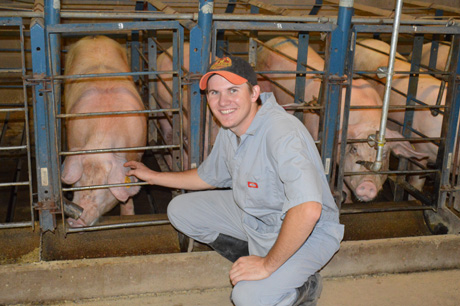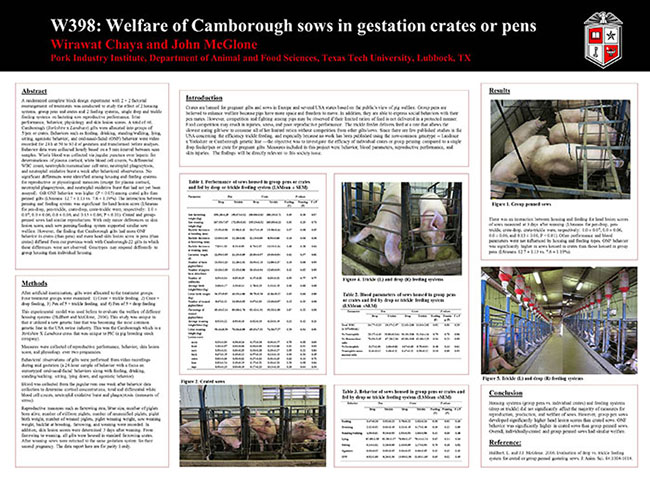The Sow Housing Site
Table of Contents
- What do we mean by sow housing?
- Why is sow housing a contemporary topic?
- Mark Kaufman story on sow housing
- Recent Sow Housing Writings & Presentations
- Presentations & Historical Documents
- Sow Housing in the News
What do we mean by sow housing?
By sow housing, the industry refers to the method of housing, penning, and caring for breeding, pregnant or lactating sows. Most often, the "sow housing issue" refers to how pregnant sows are kept. The sow housing choices refer to three primary housing system components:
- How sows are housed; that is, indoors or outdoors
- How sows are fed; that is, pregnant sows are often limit fed to meet their nutrient requirements but to prevent obesity -- this means the pregnant sow is often hungry
- How sows are penned; sows could be in an individual crate (or stall), or they may be in a variety of pen (meaning group housing) configurations with complete ability to socially interact with other sows.
- How sows are supported; Penning type also includes a type of flooring. The main floor type used today is concrete slatted flooring. Other floor types include solid concrete flooring, bedded surfaces (using, for example, wheat straw bedding) or outdoor

The hot-button issue in sow housing is the objection to keeping pregnant sows in gestation crates sometimes called stalls). Countries and US states have banned this “housing” system (it is actually a penning system). The Federation of Animal Sciences Animal Care Committee held a webinar on the topic. The webinar was recorded and can be view at this link: http://www.fass.org/2012animalcareseries/gestation/
Back to topWhy is sow housing a contemporary topic?

The sow housing issue has increased in attention for two primary reasons. First, Europe passed a law some years ago that banned the use of tethers for sows during gestation. Recently, the EU has begun a phase-out of gestation crates (stalls). Stalls are not be on farms by the year 2013; other requirements are also imposed. The EU claimed to make this requirement based on the available science (a view contested by the US pork industry). The EU scientific report is available here
Second, market forces are driving the animal welfare issue in all farm animal species. Activist groups are pressuring fast food and supermarket companies to adopt strict animal welfare requirements, often including not allowing the use of gestation crates. The food retailers and others would like to see consistent animal welfare laws around the world. Thus, some groups would like the EU laws to apply in North America (and elsewhere).
What does the EU say about the sow housing issue? The EU would like the following to happen with pregnant (dry) sows. They should have:
- Social contact (group housing or a ban of crates and tethers)
- Provision of permanent access to rooting materials (such as bedding)
- Pigs must have access to areas to feed simultaneously, with some exceptions (For more information on this point related to ESF systems click here).
The EU general rules for all common farm animal species are found here
Specific EU pig requirements are found here
Back to topMark Kaufman story on sow housing
Back to topRecent Sow Housing Writings & Presentations
- An overview the current status of sow housing and sow housing options(this presentation contains a short movie of sow bar biting)
- Alternative Sow Housing Systems: driven by legislation, regulation, free trade and
free market systems (but not science)
(this was a paper presented at the Jan, 2001 annual meeting of the Manitoba Pork Producers, Winnipeg, Manitoba, Canada) - Animal well-being issues associated with international trade, production and animal health (a paper presented at FAIR 2002)
- 2004 ASAS annual meeting abstracts on Sow Housing
- 2004 Review of Gestating Sow Housing Systems based on productivity, behavior and physiology (pdf file).
Link to recent papers in the scientific literature:
(these are pdf files; you will need Adobe Acrobat to open them)
- McGlone, J. J. and S. D. Fullwood. 2001. Behavior, reproduction, and immunity of crated pregnant gilts: Effects of high dietary fiber and rearing environment. J. Anim. Sci. 79:1466-1474.
- Johnson, A. K., J. L. Morrow-Tesch and J. J. McGlone. 2001. Behavior and performance of lactating sows and piglets reared indoors and outdoors. J. Anim. Sci. 79:2571-2579.
- McGlone, J. J. 2001. Farm animal welfare in the context of other society issues: towards sustainable systems. Livestock Production Science. 72:75-81.
- L. E. Hulbert and J. J. McGlone. 2006. Evaluation of drop versus trickle-feeding systems for crated or group-penned gestating
sows. J. Anim. Sci. 2006. 84:1004–1014
(Tricke Feeding Corrected Table 3)
Presentations & Historical Documents
- Welfare of Camborough sows in gestation crates or pens, Wirawat Chaya and John McGlone, 2012

- Abstracts for presentation at the 2003 annual ASAS meeting
-- Three abstracts on trickle vs. drop feeding and crates vs. pens for pregnant gilts; performance, behavior and immune measures. - The Crate (updated since the 2002 Pork Academy by McGlone)
- History of the crate and tether (reprints from old magazines)
January, 1969: Partial use of gestation crates
Roy Poage, Lubbock, TX featured in Hog Farm Management
February, 1969: First pictures of sows tethered
Raymond Wolford, Wabash, IN featured in Hog Farm Management
December, 1969: First pictures of sows in crates
Jack Hess, Paradise, PA featured in Hog Farm Management - Two-part movie of Lubbock Swine Breeder's 1964 farm (large files, beware)
Supplied by Mr. Roy Poage, now retired
Sow Housing in the News
- Hog housing series starts tomorrow
- Sows' gestation stalls come under scrutiny
- Gestation sow housing 'complex'
- Group housing a matter of choice
- Individual housing ideal for family's hogs
- Research needed for group housing
- Hog housing not pressing issue in Norfolk
References from Our Laboratory
Reviews of Gestation Sow Housing Systems- McGlone, J.J. 2013. The Future of Pork Production in the World: Towards Sustainable, Welfare-Positive Systems. Animals. 3(2): 401-415.
- McGlone, J.J. 2013. Review: Updated scientific evidence on the welfare of gestating sows kept in different housing systems. Prof. Animal Scientist. 29:189-198.
- Hulbert L.E, and J.J. McGlone. 2006. Evaluation of drop versus trickle-feeding systems for crated or group-penned gestating sows. J. Anim. Sci. 84:1004-1014.
- Rhodes Tracey R, Michael C. Appleby, Kathy, Chinn K, Lawrence Douglas, Lawrence D. Firkins, Katherine A. Houpt, Christa Irwin, John J. McGlone, Paul Sundberg, Lisa Tokach, and Robert W. Wills. 2005. A comprehensive review of housing for pregnant sows. J. American Vet Medical Assoc (JAVMA). 227(10):1580-1590.
- McGlone J.J., E. Von Borell, J. Deen, A.K. Johnson, D.G. Levis, M. Meunier-Salaun, J. Morrow, D. Reeves, J.L. Salak-Johnson, and P.L. Sundberg. 2004. Review: Compilation of the scientific literature comparing housing systems for gestating sows and gilts using measures of physiology, behavior, performance, and health. Professional Animal Scientist. 20:105-117.
Behavior of Gestating Sows
- McGlone J.J, and S.D. Fullwood. 2001. Behavior, reproduction, and immunity of crated pregnant gilts: effects of high dietary fiber and rearing environment. J. Anim. Sci. 79:1466-1474.
- Dailey Jeffery W, and John J. McGlone. 1997. Oral/nasal/facial and other behaviors of sows kept individually outdoors on pasture, soil or indoors in gestation crates. Applied Animal Behaviour Science. 52:25-43.
- Dailey Jeffery W, and John J. McGlone. 1997. Pregnant gilt behavior in outdoor and indoor intensive pork production systems. Applied Animal Behaviour Science. 52:45-52.
- McGlone John, J., Chana K. Akins, and Ronnie D. Green. 1991. Genetic variation of sitting frequency and duration in pigs. Applied Animal Behaviour Science. 30:319-322.
Heat Stress and Photoperiod for Lactating Sows
- McGlone, John J., Wayne F. Stansbury, Leland F. Tribble, and Julie L. Morrow. 1988. Photoperiod and heat stress influence on lactating sow performance and photoperiod effects on nursery pig performance. J. Anim. Sci. 66:1915-1919.
- Stansbury Wayne F., John J. McGlone and Leland F. Tribble. 1987. Effects of season, floor type, air temperature and snout coolers on sow and litter performance. J. Anim. Sci. 65:1507-1513.
Alternatives to the Gestation Crate
- Hulbert L.E, and J.J. McGlone. 2006. Evaluation of drop versus trickle-feeding systems for crated or group-penned gestating sows. J. Anim. Sci. 84:1004-1014.
- McGlone J.J, B. Vines, A.C. Rudine, and P. DuBois. 2004. The physical size of gestating sows. J. Anim. Sci. 82:2421-2427.
- McGlone John J., Janeen L. Salak-Johnson, Rhonada I. Nicholson, Tiffanie Hicks. 1994. Evaluation of crates and girth tethers for sows: reproductive performance, immunity, behavior and ergonomic measures. Applied Animal Behaviour Science. 39:297-311.
Alternatives to the Farrowing Crate
- Johnson A.K, and J.J. McGlone. 2003. Fender design and insulation of farrowing huts: Effects on performance of outdoor sows and piglets. J. Anim. Sci. 81:955-964.
- Johnson A.K, J.L. Morrow-Tesch, J.J. McGlone. 2003. Behavior and performance of lactating sows and piglets reared indoors or outdoors. J. Anim. Sci. 79:2571-2579.
- Sarignac, Catherine, J.P. Signoret, J.J. McGlone. 1997. Relation Mere-Jeune, Comportement et performances en function du systeme de logement et de l'environnement social. Journees Rech. Porcine en France, 29:123-128.
- McGlone John, J. and Julie Morrow-Tesch. 1990. Productivity and behavior of sows in level vs. sloped farrowing pens and crates. J. Anim. Sci. 68:82-87.
- McGlone John J. 1987. An examination of behavioral, immunological and productive traits in four management systems for sows and piglets. Applied Animal Behaviour Science. 18:269-286.
Food Safety
- T.R. Callaway, J.L. Morrow, A.K. Johnson, J.W. Dailey, F.M. Wallace, E.A. Wagstrom, J.J. McGlone, A.R. Lewis, S.E. Dowd, T.L. Poole, T.S. Edirngton, R.C. Anderson, K.J. Genovese, J.A. Byrd, R.B. Harvey, and D.J. Nisbet. 2005.Environmental Prevalence and Persistence of Salmonella spp. in Outdoor Swine Wallows. Foodborne Pathogens and Disease. 2:263-273.
Other Sow Housing Literature
- Broom, D., Mendl, M., & Zanella, A. (1995). A comparison of the welfare of sows in different housing conditions. Animal Science,61(2), 369-385. doi:10.1017/S1357729800013928.
- Averós, X., Brossard, L., Dourmad, J.-Y., de Greef, K. H., Edge, H. L., Edwards, S. A., & Meunier-Salaün, M.-C. (2010). A meta-analysis of the combined effect of housing and environmental enrichment characteristics on the behaviour and performance of pigs. Applied Animal Behaviour Science, 127(3-4), 73–85. https://doi.org/10.1016/J.APPLANIM.2010.09.010.
Back to top
For questions or comments, please email: Dr. John J. McGlone
Back to top
Laboratory of Animal Behavior, Physiology and Welfare
-
Address
1308 Indiana Ave Lubbock, TX 79409-2141 -
Phone
806.834.8275 -
Email
john.mcglone@ttu.edu
